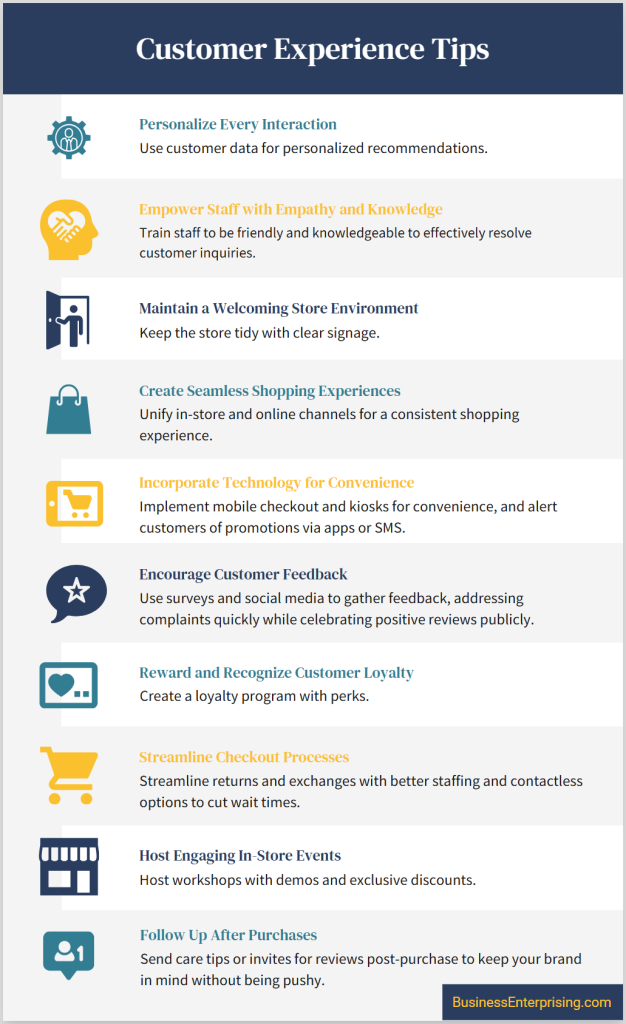 Customer experience tips help businesses improve satisfaction and build loyalty in a competitive market. Understanding your customers’ needs allows you to tailor services effectively. Additionally, creating a welcoming in-store atmosphere encourages shoppers to linger and explore. Implementing an omnichannel strategy ensures consistency across all platforms, enhancing satisfaction. Moreover, personalized service makes customers feel valued, fostering loyalty.
Customer experience tips help businesses improve satisfaction and build loyalty in a competitive market. Understanding your customers’ needs allows you to tailor services effectively. Additionally, creating a welcoming in-store atmosphere encourages shoppers to linger and explore. Implementing an omnichannel strategy ensures consistency across all platforms, enhancing satisfaction. Moreover, personalized service makes customers feel valued, fostering loyalty.
Effectively handling complaints and feedback turns challenges into opportunities for improvement. Leveraging technology, such as AI chatbots and mobile apps, streamlines the shopping journey. By focusing on these strategies, you can create a more engaging and satisfying experience for your customers.
Understanding Your Customers’ Needs
Understanding your customers’ needs is essential for tailoring the shopping experience to their preferences. Gathering insights through surveys, feedback, and data analysis provides valuable information to achieve this goal.
Surveys are a direct method to collect customer opinions. By asking specific questions about products, services, and overall satisfaction, you gain insights into what works and what needs improvement. For instance, post-purchase surveys can reveal customer satisfaction levels and highlight areas needing attention.
Customer feedback, whether solicited or unsolicited, offers a wealth of information. Monitoring online reviews and social media comments allows you to understand customer sentiments. This feedback can uncover common pain points and areas where your business excels. Addressing these insights can lead to improved customer satisfaction.
Data analysis complements surveys and feedback by providing a broader view of customer behavior. Analyzing purchase histories, website navigation patterns, and transaction data uncovers trends and preferences. This information helps in personalizing marketing efforts and inventory management.
Combining these methods offers a comprehensive understanding of your customers. Implementing these customer experience tips can lead to more personalized interactions, fostering loyalty and repeat business.
Creating a Welcoming In-Store Atmosphere
Creating a welcoming in-store atmosphere is key to enhancing customer comfort and engagement. A well-thought-out store layout guides customers effortlessly through your space. By strategically placing displays and merchandise, you can encourage exploration and highlight key products. This thoughtful arrangement not only showcases your offerings but also makes the shopping experience more enjoyable.
Lighting plays a significant role in setting the store’s mood. Soft, warm lighting creates a cozy environment, while brighter lights can energize the space. Adjusting lighting to highlight specific products can draw attention and influence purchasing decisions. Therefore, consider how different lighting setups can impact customer perceptions and behaviors.
Music also affects how customers feel and move within your store. Upbeat tunes can invigorate shoppers, encouraging them to move through the space more quickly. In contrast, slower melodies can promote relaxation, leading customers to linger longer. Choosing music that aligns with your brand and target audience enhances the overall experience.
Scent is another subtle yet powerful tool in crafting a pleasant atmosphere. Inviting aromas can evoke positive emotions and memories, making the shopping experience more enjoyable. For instance, a hint of vanilla or lavender can create a calming effect, encouraging customers to spend more time in your store. Thus, incorporating pleasant scents can be an effective addition to your customer experience strategies.
By thoughtfully integrating these elements—layout, lighting, music, and scent—you can create an inviting environment that resonates with your customers. Implementing these customer experience tips can lead to increased satisfaction and loyalty, ultimately benefiting your business.
Omnichannel Experience: Seamless Online & Offline Integration
Providing a consistent experience across e-commerce, social media, and physical stores is essential for meeting customer expectations. An effective omnichannel strategy integrates these channels, allowing customers to transition smoothly between them. For instance, offering services like “buy online, pick up in-store” (BOPIS) enables customers to shop conveniently. This approach not only enhances convenience but also encourages additional in-store purchases.
Maintaining consistent branding across all platforms reinforces your brand identity. Ensure that your website, social media profiles, and physical stores share a unified look and feel. This consistency helps customers recognize your brand, regardless of how they engage with it. Additionally, aligning marketing messages across channels prevents confusion and builds trust.
Integrating customer data from various touchpoints allows for personalized interactions. By analyzing data from online purchases, social media interactions, and in-store visits, you can tailor marketing efforts to individual preferences. This personalization can lead to increased customer loyalty and higher sales.
Training staff to be knowledgeable about both online and offline offerings ensures a seamless customer experience. For example, if a product is unavailable in-store, employees should assist customers in ordering it online. This level of service demonstrates a commitment to meeting customer needs across all channels.
Implementing these customer experience tips can help your business provide a cohesive and engaging shopping journey. By focusing on seamless integration, consistent branding, personalized interactions, and well-informed staff, you can meet customer expectations and foster loyalty.
The Power of Personalized Service
Personalized service significantly enhances customer satisfaction and loyalty. By tailoring interactions to individual preferences, you make customers feel valued and understood. This approach fosters a deeper connection between your brand and its patrons.
Personalized recommendations play a pivotal role in this strategy. By analyzing customer behavior and purchase history, you can suggest products or services that align with their interests. This not only increases the likelihood of a sale but also demonstrates attentiveness to their needs. Consequently, customers are more inclined to return, knowing they will find relevant offerings.
Loyalty programs further strengthen this bond. By rewarding customers for their continued patronage, you incentivize repeat business. Tailoring these programs to individual preferences enhances their effectiveness. For example, offering personalized discounts or early access to new products makes customers feel appreciated. Therefore, they are more likely to remain loyal to your brand.
Proactive customer support is another essential element. By anticipating issues and addressing them before they escalate, you show a commitment to customer satisfaction. For instance, reaching out to a customer if there’s a delay in their order demonstrates responsibility. This proactive approach can prevent dissatisfaction and build trust.
Implementing these customer experience tips can lead to higher retention rates. When customers feel valued and understood, they are more likely to continue choosing your brand over competitors. This not only boosts satisfaction but also contributes to long-term business success.
Handling Customer Complaints & Feedback Effectively
Effectively handling customer complaints and feedback is essential for maintaining satisfaction and loyalty. When a customer voices a concern, listen attentively to understand the issue fully. This active listening demonstrates respect and a commitment to resolving their problem. Additionally, by addressing complaints promptly, you can prevent minor issues from escalating into major dissatisfaction.
After understanding the complaint, work collaboratively with the customer to find a suitable solution. Offering options empowers them and shows flexibility in meeting their needs. For instance, providing a replacement or refund can turn a negative experience into a positive one. Therefore, being proactive in offering resolutions can enhance customer trust.
Moreover, view feedback as an opportunity for improvement. By analyzing recurring complaints, you can identify areas needing change. Implementing these changes not only addresses individual concerns but also enhances overall service quality. Consequently, leveraging feedback effectively can lead to continuous improvement.
Following up with customers after resolving their issues further solidifies trust. A simple check-in shows that you value their satisfaction beyond the initial resolution. This practice can lead to increased loyalty and positive word-of-mouth. Implementing these customer experience tips can significantly boost retention and satisfaction.
Leveraging Technology to Enhance Customer Experience
Integrating technology into your retail operations can significantly enhance the customer experience. AI chatbots, for instance, provide instant responses to customer inquiries, offering support around the clock. This immediate assistance can increase satisfaction and encourage repeat business.
Mobile apps also play a crucial role in streamlining the shopping journey. By offering features like personalized recommendations and exclusive deals, apps keep customers engaged and informed. Additionally, they facilitate easy access to your products and services, enhancing convenience.
Self-checkout systems expedite the purchasing process, reducing wait times. Customers appreciate the autonomy to scan and bag items at their own pace. However, it’s important to provide assistance when needed to ensure a smooth experience.
Contactless payment options further simplify transactions. By allowing customers to pay with a tap of their card or smartphone, you enhance both speed and safety. Therefore, adopting these methods can lead to higher customer satisfaction.
Implementing these customer experience tips can make your retail environment more efficient and appealing. By leveraging technology thoughtfully, you meet modern consumer expectations and foster loyalty.
Conclusion
Enhancing customer experience is essential for fostering loyalty and driving business growth. By understanding your customers’ needs, you can tailor your services to meet their expectations. Additionally, creating a welcoming in-store atmosphere encourages customers to spend more time exploring your offerings. Implementing an omnichannel strategy ensures a seamless experience across all platforms, further strengthening customer satisfaction. Moreover, personalized service makes customers feel valued, increasing their likelihood of returning.
Effectively handling complaints and feedback turns negative experiences into positive ones, showcasing your commitment to improvement. Leveraging technology, such as AI chatbots and mobile apps, streamlines the shopping journey, making it more convenient for your customers. By applying these customer experience tips, you can create a more engaging and satisfying environment for your clientele.




